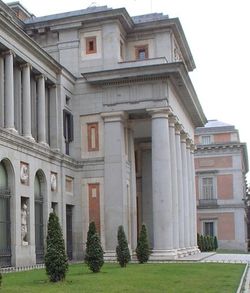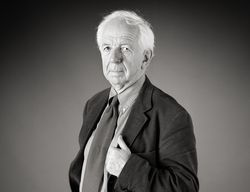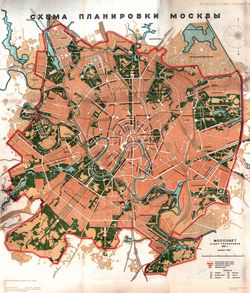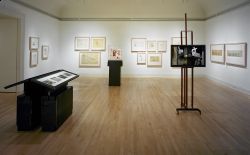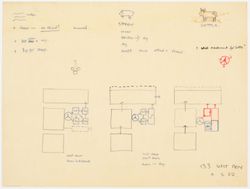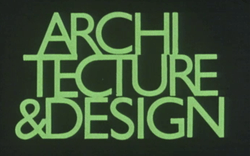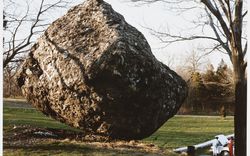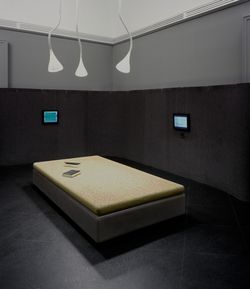5 August 2010
Hubert Damisch, 2003-2004 CCA Mellon Senior Fellow, examines Blur – the cloud building created by New York architects Diller + Scofidio on lake Neuchâtel in Switzerland, which is the most recent and radical expression of the desire for fluidity and evanescence in architecture – and the consequences that it might have on the future of structural thought. Damisch examines(...)
Paul Desmarais Theatre
8 May 2003
Hubert Damisch: “Effacer l’architecture?”
Actions:
Description:
Hubert Damisch, 2003-2004 CCA Mellon Senior Fellow, examines Blur – the cloud building created by New York architects Diller + Scofidio on lake Neuchâtel in Switzerland, which is the most recent and radical expression of the desire for fluidity and evanescence in architecture – and the consequences that it might have on the future of structural thought. Damisch examines(...)
Paul Desmarais Theatre
Join us tonight, 9 June 2011 at 6 pm in the Shaughnessy House. Visiting Scholar Elisabeth Essaïan presents her research on urban planning during the Stalin era, and a critical assessment of the reception it received in European and North American publications from the 1920s to 1950s. Presented in French. Click here for the Facebook event. Consult the summer seminar(...)
Shaughnessy House
9 June 2011 , 6pm
Visiting Scholar Seminar: Elisabeth Essaïan
Actions:
Description:
Join us tonight, 9 June 2011 at 6 pm in the Shaughnessy House. Visiting Scholar Elisabeth Essaïan presents her research on urban planning during the Stalin era, and a critical assessment of the reception it received in European and North American publications from the 1920s to 1950s. Presented in French. Click here for the Facebook event. Consult the summer seminar(...)
Shaughnessy House
The exhibition addresses a central and timely aspect of the work of Carlo Scarpa: its distinctive approach to contending with the layers of history that mark the fabric of a city and a building. In addressing Scarpa’s ability to weave new work into, and often out of, the disparate fragments of the old, Carlo Scarpa, Architect: Intervening with History begins to unravel(...)
Main galleries
26 May 1999 to 31 October 1999
Carlo Scarpa, Architect: Intervening with History
Actions:
Description:
The exhibition addresses a central and timely aspect of the work of Carlo Scarpa: its distinctive approach to contending with the layers of history that mark the fabric of a city and a building. In addressing Scarpa’s ability to weave new work into, and often out of, the disparate fragments of the old, Carlo Scarpa, Architect: Intervening with History begins to unravel(...)
Main galleries
exhibitions
Learning Architecture
As architecture acquired its modern identity as both a liberal art and a regulated profession, and as architectural theories and forms underwent radical transformations, the training of architects did not fundamentally change. The core activities of architectural students remain “Authority,” the study of treatises and theoretical works, “Observation,” the study of the(...)
Hall cases
5 July 1994 to 2 October 1994
Learning Architecture
Actions:
Description:
As architecture acquired its modern identity as both a liberal art and a regulated profession, and as architectural theories and forms underwent radical transformations, the training of architects did not fundamentally change. The core activities of architectural students remain “Authority,” the study of treatises and theoretical works, “Observation,” the study of the(...)
exhibitions
5 July 1994 to
2 October 1994
Hall cases
Meat and dairy products are ubiquitous ingredients in the globe’s diet. However, the buildings that transform living beings into commodities are usually hidden from the public eye. The architecture of factory farming may seem anonymous and banal, and yet it is made possible by sophisticated technologies and practices of biosecurity. How was the design of intensive animal(...)
20 July 2023, 6pm to 7:30pm
Cages for non-humans: An architectural history of animal farming
Actions:
Description:
Meat and dairy products are ubiquitous ingredients in the globe’s diet. However, the buildings that transform living beings into commodities are usually hidden from the public eye. The architecture of factory farming may seem anonymous and banal, and yet it is made possible by sophisticated technologies and practices of biosecurity. How was the design of intensive animal(...)
articles
A history of references
articles
30 November 2017
Philip Ursprung, guest curator of the 2002 CCA exhibition Herzog de Meuron: Archaeology of the Mind, discusses the Swiss architects’ collaborative relationship with artists. The lecture is part a series exploring the boundary between art and architecture, presented in conjunction with the exhibition. Philip Ursprung is Professor of the History of Modern and Contemporary(...)
17 October 2002
Philip Ursprung: Close Encounters: Herzog & de Meuron en collaboration avec des artistes
Actions:
Description:
Philip Ursprung, guest curator of the 2002 CCA exhibition Herzog de Meuron: Archaeology of the Mind, discusses the Swiss architects’ collaborative relationship with artists. The lecture is part a series exploring the boundary between art and architecture, presented in conjunction with the exhibition. Philip Ursprung is Professor of the History of Modern and Contemporary(...)
